Aquarium Conditioned
Naso Tang
Naso lituratus (Indonesia)
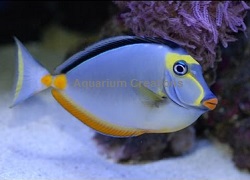
Click to view Video Lipstick Naso Tang
Description:
The Naso tang is a very personable fish that once its comfortable can be trained to accept foods from its keeper's hand. A little shy at first, it takes a little time to acclimate to aquarium life. Being a peaceful fish with an amicable nature, it will get along with most other marine fish. Though it can be kept with a variety of tank mates this species has been known to get aggressive with other surgeonfish, especially those of its own genus. Unless you have a huge (hundreds of gallons) system, it is best to house just one Naso tang to a tank.
Tank Recommendations:
Typically fares notably better in reef aquariums than in fish only tanks. This handsome fish is very active; thus, it is important to provide it with plenty of swimming space. A small or medium Naso Tang requires a minimum of 55 gallons, of course you will need a larger tank as it grows. A Large Naso Tang should be housed in at least a 150 gallon tank. Like all tangs, the Naso likes a lot of water turbulence rather than a placid aquarium. Being very active during the day they need a large tank with plenty of room to swim about but will also need rocks/ corals to provide some cover and to sleep in at night. As they are primarily herbivores they ignore invertebrates, but lush natural algae growth will be greatly appreciated. Once they get acclimated and become accustom to aquarium foods they are quite hardy and long lived.
Food and diet:
The Naso Tangs are primarily herbivores. In the wild they feed mainly on leafy brown algae like Sargassum and Dictyota. Provide lots of algae, prepared frozen formulas containing algae or spirulina, and flakes. Japanese Nori or other seaweed can be adhered to the aquarium glass with a vegetable clip. It will also feed on some frozen brine and mysis shrimp. Some hobbyists also have great success with supplemental foods such as previously boiled or frozen zucchini, broccoli, spinach, and leaf lettuce. For the health of your fish it is always desirable to soak all fish food including algae with vitamins to help keep your fish healthier and less susceptible to disease. Another helpful tip is to soak your fishes food in garlic as well. Especially when adding new fish and whenever your notice ich or other disease in the aquarium. Garlic helps repel external parasites, such as ich, and boosts immunity in all your fish.
Level of Care:
Moderate
Acclimaton Time:
2+ hours
Reef Compatibility:
Great reef fish. Typically fares notably better in reef aquariums than in fish only tanks.
Approximate Purchase Size:
Small 2" to 2-1/2" Medium 2-1/2" to 4-1/2" Large 4-1/2" to 6-1/2" XLarge 6-1/2" to 7-1/2" XXLarge 7-1/2" to 9"
|
Small, $99.99
Medium,$139.99
Medium/Large,$169.99
Female Large, $249.99
Male Large, $289.99
Female XLarge, $389.99
Male XLarge, $499.99
Female XXLarge, $449.99
Male XXLarge, $599.99
|
|
Aquarium Conditioned
Blonde Naso Tang
Naso elegans (Maldives)
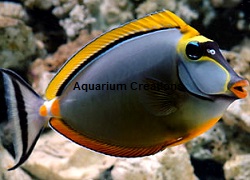
Click to view Video Lipstick Naso Tang
Description:
The Blonde Naso Tang, Naso lituratus, is also known as the Elegant Unicornfish. These fish come from the Indian Ocean region. They have a gray body with yellow along the top of the body and orange along the belly. For Males, the caudal fin develops beautiful elongated filaments or streamers from each corner when mature. Like all Naso species, they have the ability to quickly and dramatically change, depending on mood or environment. When excited or hiding in the reef their body can become almost black with gray splotchy patches. Tangs are also known as surgeonfish because they have a scalpel-like spine at the base of the tail, be sure to handle them with care! Blonde Naso Tangs can reach up to 18″ and require an aquarium of at least 180 gallons with strong water flow and lots of swimming area.
Tank Recommendations:
Typically fares notably better in reef aquariums than in fish only tanks. This handsome fish is very active; thus, it is important to provide it with plenty of swimming space. A small or medium Blonde Naso Tang requires a minimum of 55 gallons, of course you will need a larger tank as it grows. A Large Blonde Naso Tang should be housed in at least a 150 gallon tank. Like all tangs, the Blonde Naso likes a lot of water turbulence rather than a placid aquarium. Being very active during the day they need a large tank with plenty of room to swim about but will also need rocks/ corals to provide some cover and to sleep in at night. As they are primarily herbivores they ignore invertebrates, but lush natural algae growth will be greatly appreciated. Once they get acclimated and become accustom to aquarium foods they are quite hardy and long lived.
Food and diet:
The Naso Tangs are primarily herbivores. In the wild they feed mainly on leafy brown algae like Sargassum and Dictyota. Provide lots of algae, prepared frozen formulas containing algae or spirulina, and flakes. Japanese Nori or other seaweed can be adhered to the aquarium glass with a vegetable clip. It will also feed on some frozen brine and mysis shrimp. Some hobbyists also have great success with supplemental foods such as previously boiled or frozen zucchini, broccoli, spinach, and leaf lettuce. For the health of your fish it is always desirable to soak all fish food including algae with vitamins to help keep your fish healthier and less susceptible to disease. Another helpful tip is to soak your fishes food in garlic as well. Especially when adding new fish and whenever your notice ich or other disease in the aquarium. Garlic helps repel external parasites, such as ich, and boosts immunity in all your fish.
Level of Care: Moderate
Acclimaton Time: 2+ hours
Reef Compatibility:
Great reef fish. Typically fares notably better in reef aquariums than in fish only tanks.
Approximate Purchase Size: Small 2" to 2-1/2" Medium 2-1/2" to 4-1/2" Large 4-1/2" to 6-1/2" XLarge 6-1/2" to 7-1/2" XXLarge 7-1/2" to 9"
|
Small, Indian Ocean
$139.99
Medium, Indian Ocean
$179.99
Female Large, Indian Ocean
$239.99
Male Large, Indian Ocean
$299.99
Female XLarge, Indian Ocean
$359.99
Male XLarge, Indian Ocean
$459.99
Female XXLarge, Indian Ocean
$529.99
Male XXLarge, Indian Ocean
$649.99
|
|
Yellow Tangs
Zebrasoma flavescens
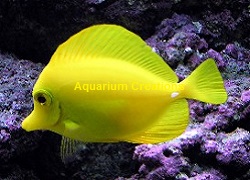
The Last Of The Yellow Tangs
Description:
Hawaii has shut down exporting live saltwaterfish. These for sale were obtained prior to the change. One of the most well known, popular fish in the marine hobby. A member of family Acanthuridae it has a beautiful oval shaped body possessing a single pastel-like yellow color along with long continuous dorsal, anal fins and crescent tailfins. It has sharp white razor spur near the tail, which it uses during fights and also to establish itself over other fishes. When sleeping or stressed a white line appears on the flanks of this fish. If you are going to keep more than one tang in the same tank it is best to introduce them simultaneously, or to introduce smaller individuals first. A good community or reef aquarium fish. Fairly resistant to diseases, the Yellow Tang is relatively easy to care for. It can be housed in groups of 3 or more as a shoal, or singly. It will also defend a preferred hiding place from intruders. Provide this active fish with plenty of swimming room, as well one or two hiding places.
Tank Recommendations:
Will do best in a reef aquarium with plenty of live rock and hiding places. It should be housed in an aquarium of at least 100 gallons with ample room to swim. Like other Tangs, this member of the Acanthuridae family demonstrates territorial aggression towards its own species, or Tangs in general. Therefore, it is best to keep either one Yellow Hawaiian Tang per aquarium or 3 or more Yellow Hawaiian Tangs and introduce all into the system simultaneously.
Food and diet:
Yellow Tangs are primarily herbivores. In the wild they feed mainly on leafy brown algae like Sargassum and Dictyota. Provide lots of algae, prepared frozen formulas containing algae or spirulina, and flakes. Japanese Nori or other seaweed can be adhered to the aquarium glass with a vegetable clip. It will also feed on some frozen brine and mysis shrimp. Some hobbyists also have great success with supplemental foods such as previously boiled or frozen zucchini, broccoli, spinach, and leaf lettuce. For the health of your fish it is always desirable to soak all fish food including algae with vitamins to help keep your fish healthier and less susceptible to disease. Another helpful tip is to soak your fishes food in garlic as well. Especially when adding new fish and whenever your notice ich or other disease in the aquarium. Garlic helps repel external parasites, such as ich, and boosts immunity in all your fish.
Level of Care: Easy
Acclimaton Time: 2+ hours
Reef Compatibility:
Great hardy addition to any fish-only or reef aquarium system.
Approximate Purchase Size:
Small 1-1/4" to 2" Medium 2" to 3" Medium/Large 3" to 4 Large 4" to 5-3/4"
|
Small $349.99
Medium $449.99
Large $599.99
|
|
Captive-Bred
Blue Hippo Tangs
Paracanthurus hepatus
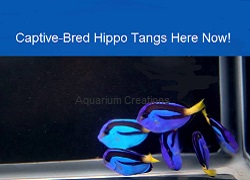
Click to view Captive-Bred Blue Hippo Tangs
Description:
We are proud to offer Captive-Bred Blue Hippo Tangs. Guaranteed to be 100% Spawned and Raised in captivity and will immediately accept a variety of foods that are readily available for saltwater aquarium fish. They are fully acclimated to aquarium life and much more hardy than wild collected specimens. Of the thousands of fish available to the trade, this is one of the most popular of them all! Shy, especially when first introduced to the aquarium, the Blue Tang should be provided with coral, live rock, or other suitable shelter sites. The Blue Tang will lie on is side (often startling those unaware of it's behavior) if it cannot find a suitable hiding place, or when first introduced into the aquarium. Once settled into an aquarium, this is an active and remarkably peaceful fish and one which can be mixed with almost any other species, including other surgeonfish. In larger aquariums, its also possible to keep multiple Blue Hippo Tangs together, though there will often be some fighting between them as they work out a dominance hierarchy. If possible, purchase smaller specimens and add them together, as this will usually reduce problems with aggression. This species is usually more docile than many other Surgeonfishes, and gets along great in a peaceful community or reef tank.
Tank Recommendations:
With a maximum size of around eight inches, this energetic species will need a suitably large fish tank when fully grown, with a recommended size being 180 gallon. For the smaller Captive Bred Blue Hippo Tangs we recommend at least a 40 gallon aquarium but suggest a minimum size of 55 gallons if multiple fish will be included. Remember they are very active during the day therefore they need a larger tank than one would think, with plenty of room to swim about but will also need rocks/ corals to provide some cover and to sleep in at night. As they are primarily herbivores they ignore invertebrates, but lush natural algae growth will be greatly appreciated. Once they get acclimated and become accustom to aquarium foods they are quite hardy and long lived
Food and diet:
Many people purchase Blue Hippo Tangs based on an assumption that like the rest of it's Tang cousins, it will consume problem algae in the aquarium. Sometimes as an adult it will consume algae as a supplement to it's regular diet, but it's staple diet consists of plankton and meaty foods. Feed frozen mysis shrimp, finely chopped raw shrimp, flake, pellet and frozen preparations. They will also enjoy eating frozen preparations for herbivores. For the health of your fish it is always desirable to soak all fish food including algae with vitamins to help keep your fish healthier and less susceptible to disease. Another helpful tip is to soak your fishes food in garlic as well. Especially when adding new fish and whenever your notice ich or other disease in the aquarium. Garlic helps repel external parasites, such as ich, and boosts immunity in all your fish.
Level of Care:
Easy (Captive Bred)
Acclimaton Time:
2+ hours
Reef Compatibility:
Great reef fish. Typically fares notably better in reef aquariums than in fish only tanks.
Approximate Purchase Size:
Small: 1" to 1-1/2" Medium: 2" to 2-1/2" Large: 3" to 4"
|
Small $169.99
Medium $199.99
|
|
Aquarium Conditioned
Blue Hippo Tang
Paracanthurus hepatus(Indonesia)
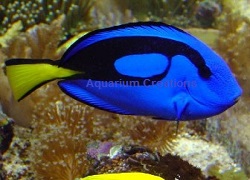
Click to View Blue Hippo Tangs
Description:
The Blue Tang also called the Blue Hippo Tang is a beautiful royal blue, with a black palette pattern on the side and a yellow tail. Of the thousands of fish available to the trade, this is one of the most popular of them all! Shy, especially when first introduced to the aquarium, the Blue Tang should be provided with coral, live rock, or other suitable shelter sites. The Blue Tang will lie on is side (often startling those unaware of it's behavior) if it cannot find a suitable hiding place, or when first introduced into the aquarium. In captivity, P. hepatus is an easy and hearty species to care for, though many aquarists often struggle with it. Like most other surgeonfishes, this species is prone to Cryptocaryon (=saltwater ich) infection which, if left untreated, will often kill this fish quite quickly. To avoid this issue, it is wise to buy from a reliable source and to always quarantine in a separate aquarium. Another common malady is fin erosion and color loss, which is usually the result of poor water conditions. Once settled into an aquarium, this is an active and remarkably peaceful fish and one which can be mixed with almost any other species, including other surgeonfishes. In larger aquariums, its also possible to keep multiple Blue Hippo Tangs together, though there will often be some fighting between them as they work out a dominance hierarchy. If possible, purchase smaller specimens and add them together, as this will usually reduce problems with aggression. This species is usually more docile than many other Surgeonfishes, and gets along great in a peaceful community or reef tank.
Tank Recommendations:
With a maximum size of around eight inches, this energetic species will need a suitably large fish tank when full grown, with a recommended size being 180 gallon. The Blue Hippo Tang is a poor choice for a beginner aquarist with a small aquarium, smaller Blue Tangs may be put in 70 gallon and up aquariums. Remember they are very active during the day therefore they need a larger tank than one would think, with plenty of room to swim about but will also need rocks/ corals to provide some cover and to sleep in at night. As they are primarily herbivores they ignore invertebrates, but lush natural algae growth will be greatly appreciated. Once they get acclimated and become accustom to aquarium foods they are quite hardy and long lived
Food and diet:
Many people purchase Blue Hippo Tangs based on an assumption that like the rest of it's Tang cousins, it will consume problem algae in the aquarium. Sometimes as an adult it will consume algae as a supplement to it's regular diet, but it's staple diet consists of plankton and meaty foods. Feed frozen mysis shrimp, finely chopped raw shrimp, flake, pellet and frozen preparations. They will also enjoy eating frozen preparations for herbivores. For the health of your fish it is always desirable to soak all fish food including algae with vitamins to help keep your fish healthier and less susceptible to disease. Another helpful tip is to soak your fishes food in garlic as well. Especially when adding new fish and whenever your notice ich or other disease in the aquarium. Garlic helps repel external parasites, such as ich, and boosts immunity in all your fish.
Level of Care: Moderate
Acclimaton Time:
2+ hours
Reef Compatibility:
Great reef fish. Typically fares notably better in reef aquariums than in fish only tanks.
Approximate Purchase Size:
Tiny: 1/2" to 3/4"; Small: 1" to 2"; Small/Medium: 2" to 3"; Medium 3" to 4"; Medium/Large 4" to 5"; Large: 5" to 6"; XLarge 6" to 8"
|
Tiny $99.99
Small $119.99
Small/Medium $139.99
Medium $169.99
Medium/Large $199.99
Large $229.99
XLarge $269.99
|
|
Aquarium Conditioned
Yellow Eye Kole Tang
Ctenochaetus strigosus (Hawaii)
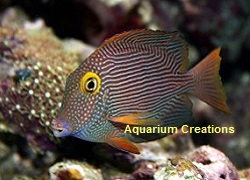 Click for Yellow Eye Kole Tang Enjoying 100 Gallons
Click for Yellow Eye Kole Tang Enjoying 100 Gallons
Description:
Also known by the Striped Bristletooth, and Goldring Bristletooth Tang, Yellow Eye Tang, or Yelloweye Surgeonfish. Easy identifiable by its reddish-brown body with lighter lines running down the entire body and a bold yellow ring around the eye. It is an active species that makes a great reef or community fish. Yellow Eye Kole Tangs are useful in keeping your aquarium looking their best. Very popular as a "maintainance" tang. They will eat a wide range of desirable and undesirable algae. It is probably one of the best Tangs for helping to control the growth of undesirable algae including diatom algae. Provide all tangs with plenty of open swimming room. In the wild they swim all over the reef grazing on algae.
Tank Recommendations: Will do best in a reef or a Fowlr aquarium, (Fish only with live rock), with plenty of live rock and hiding places. The Yellow Eye Kole Tang is a great addition to aquariums of 80 gallons or more. In larger aquariums of 200 gallons or more, you can keep a small school provided they are added at the same time. When introducing a variety of tangs to an aquarium, it is best to add them in groups to help avoid territorial disputes. Yellow Eye Kole Tangs tend to be extra aggressive towards other tangs with a similar body shape (called conspecifics) such as the Chevron Tang and Convict Tang.
Food and diet:
The Yellow Eye Kole Tang will graze over the rock searching for algae to eat. Supplement the diet with live macro algae, such as Macro Feast, dry seaweed 2-3 times per week. Try using a rubber-band to attach the algae to a small rock or pvc pipe and place it in the sand bed. For the health of your fish it is always desirable to soak all fish food including algae with vitamins to help keep your fish healthier and less susceptible to disease. Another helpful tip is to soak your fishes food in garlic as well. Especially when adding new fish and whenever your notice ich or other disease in the aquarium. Garlic helps repel external parasites, such as ich, and boosts immunity in all your fish.
Level of Care: Easy
Acclimaton Time: 2+ hours
Reef Compatibility:
Great hardy addition to any fish-only or reef aquarium system.
Approximate Purchase Size:
Small: 1-1/2" to 2"; Medium: 2" to 3-1/4"; Large: 3-1/4" to 4-1/2"
|
Small $249.99
Medium $299.99
Large $349.99
|
|






 Click for Yellow Eye Kole Tang Enjoying 100 Gallons
Click for Yellow Eye Kole Tang Enjoying 100 Gallons